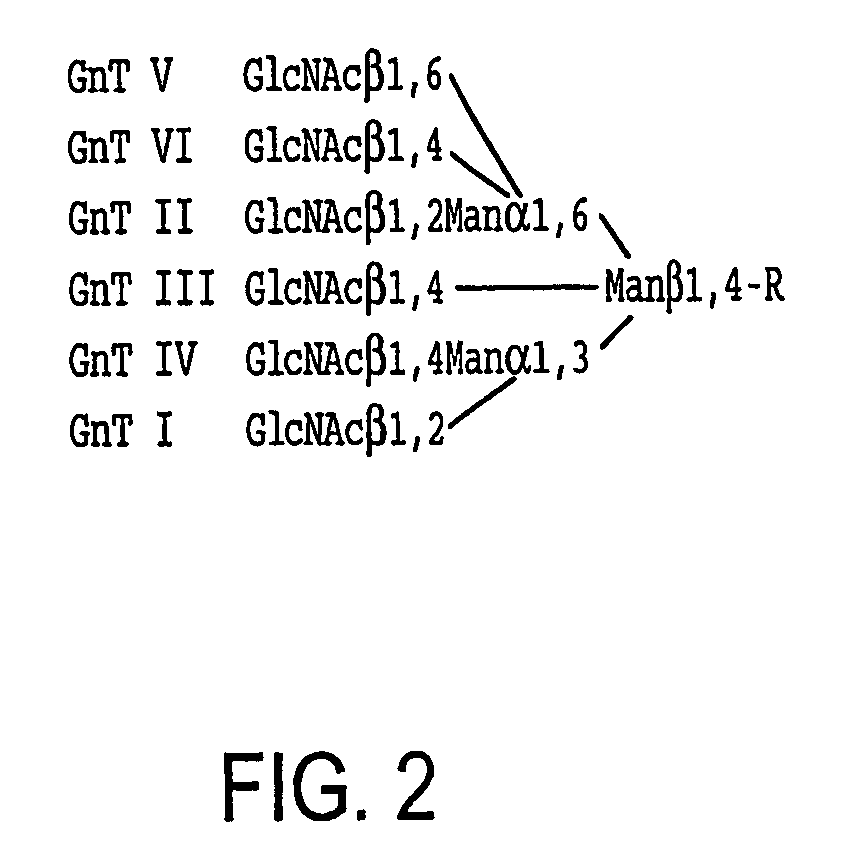Production of human glycosylated proteins in transgenic insects
a technology of glycosylated proteins and transgenic insects, which is applied in the direction of transferases, viruses/bacteriophages, enzymology, etc., can solve the problems of unrealized potential, insufficient manufacturing infrastructure in the biopharmaceutical industry to meet patient needs, and discovery far outpace production
- Summary
- Abstract
- Description
- Claims
- Application Information
AI Technical Summary
Problems solved by technology
Method used
Image
Examples
example i
General Overview of One Aspect of the Invention
[0168] A colony of lepidopteran insect larvae (Trichoplusia ni) is stably transformed with a set of genes important for mammalianizing (e.g., humanizing) their protein N-glycosylation pathways. The piggybac system is used in a series of consecutive transpositional events to translocate a set of about 2-8 or more glycosylation genes (preferably a set of about 6-8 glycosylation genes) into the germline of insect embryos. Stable incorporation of these genes results in mammalianization (humanization) of all endogenous glycoproteins. One indication that these genetic modifications are not lethal to these insects is that that the N-glycosylation pathway has been humanized in cultured insect cell lines with no obvious deleterious effects. The risk of such detrimental effects occurring is further assessed by transforming Drosophila melanogaster. This model system is amenable to more rapid experiments than is the T. ni system. In some experimen...
example ii
Experiments in Insect Cell Lines
[0170] Aspects of the invention can be carried out by adapting methods used in insect cell culture. See, e.g., U.S. Pat. No. 6,461,863. Insect cell lines were genetically transformed to create improved hosts for the production of humanized recombinant glycoproteins by baculovirus vectors. Sf9 cells were transformed with an expression plasmid encoding the cDNA for a mammalian β4Gal-TI to create a transgenic insect cell line called Sfβ4GalT (Hollister et al. (1998) Glycobiology 8, 473-80). The β4Gal-TI cDNA was placed under the control of the promoter from a baculovirus immediate early gene called ie1, which provides constitutive foreign gene expression in lepidopteran insect cells. Sfβ4GalT cells grew normally, supported baculovirus replication, and constitutively expressed the mammalian β4Gal-TI gene. In addition, unlike the parental Sf9 cells, Sfβ4GaIT cells were able to produce terminally galactosylated recombinant glycoproteins, such as human tiss...
example iii
Selecting Mammalian Processing Genes
[0173] Modifying the results of comparative analysis of the mammalian and insect protein N-glycosylation pathways, we incorporate mammalian glycosylation enzyme genes, including GlcNAc-TII, β4Gal-TI, ST6GalI, ST3GalIV, sialic acid synthase (SAS), and / or CMP-sialic acid synthetase (CMP-SAS) genes, into an insect genome to compensate for the lack of these enzymes in insect larvae. GlcNAc-TII initiates elongation of the upper branch, which is necessary to convert N-glycan intermediates to conventional biantennary structures. β4Gal-TI, ST6GalI, ST3GalIV complete the elongation and terminal sialylation of N-glycans. Both sialyltransferase genes are incorporated because ST6GalI and ST3GalIV transfer sialic acids in alpha 2,6- or alpha 2,3-linkages, respectively, and some human N-glycoproteins have one linkage, some have the other, and some have both. Since transgenic larvae may not be able to scavenge sialic acid, the SAS and CMP-SAS genes are included...
PUM
| Property | Measurement | Unit |
|---|---|---|
| Acidity | aaaaa | aaaaa |
| Molar ratio | aaaaa | aaaaa |
| Level | aaaaa | aaaaa |
Abstract
Description
Claims
Application Information
 Login to View More
Login to View More - R&D
- Intellectual Property
- Life Sciences
- Materials
- Tech Scout
- Unparalleled Data Quality
- Higher Quality Content
- 60% Fewer Hallucinations
Browse by: Latest US Patents, China's latest patents, Technical Efficacy Thesaurus, Application Domain, Technology Topic, Popular Technical Reports.
© 2025 PatSnap. All rights reserved.Legal|Privacy policy|Modern Slavery Act Transparency Statement|Sitemap|About US| Contact US: help@patsnap.com



